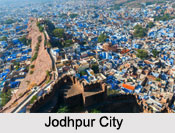 Jodhpur is the epicenter of the tourism in Rajasthan. It is the second largest region in the state of Rajasthan. It stands as a beauty in the middle of arid landscape. This medieval city is dotted with palatial buildings, forts, temples and gardens. Jodhpur draws the attraction to the tourists for Mehrangarh Fort, which is only a few kilometer from the main city. Jodhpur hosts a large number of fairs and festivals throughout the year.
Jodhpur is the epicenter of the tourism in Rajasthan. It is the second largest region in the state of Rajasthan. It stands as a beauty in the middle of arid landscape. This medieval city is dotted with palatial buildings, forts, temples and gardens. Jodhpur draws the attraction to the tourists for Mehrangarh Fort, which is only a few kilometer from the main city. Jodhpur hosts a large number of fairs and festivals throughout the year.
Location of Jodhpur
Jodhpur is located in the Jodhpur District of north-west Indian state of Rajasthan. It presents a spark of beauty in the middle of the Thar desert.
History of Jodhpur
The history of Jodhpur revolves around the rule of Rathores of Marwar. Rao Jodha, Rathore king, is said to be the founder of Jodhpur. In ancient India, Jodhpur was also known as Marwar. They mostly shared a good rapport with the Mughal Dynasty except for Mughal Emperor Aurangzeb. Jodhpur saw Mughal tortures in late medieval era and the kings of Jodhpur made several alliances with Maratha Empire. Later they made subsidiary alliance with British East India Company in 1818. Till Independence of India, Jodhpur was known as Princely State.
Climate of Jodhpur
Jodhpur enjoys tropical and sub-tropical desert climate throughout the year. The summer temperature ranges from 40 degree Celsius to 53 degree Celsius.
Demography of Jodhpur
According to the Population Census in the year 2011, the population of Jodhpur is about 1,033,918. The average literacy rate of Jodhpur is about 81.56 percent. The literacy rate of the males is about 88.42 percent, while the female literacy rate is about 73.93 percent.
Economy of Jodhpur
Jodhpur is economically flourished with the textiles. There are other industries like metal crafts, bicycles, ink, glass crafts, cutlery, carpets, marble products and sporting goods, which crater economy to the city.
 Culture of Jodhpur
Culture of Jodhpur
Jodhpur is culturally enriched with its cuisine. Lassi, Mawa Ki Kachori, Pyaaj Ki Kachori, Mirchi Bada, Dal Bati Churma, Lasan Ki Chutney, Mirchi Ka Kutaa, Gatte Ki Sabji, Ker Sangri Sabzi, Halwa, Kachara Mircha Sabzi and Kadhi Pakoda are the popular dishes here.
Tourism in Jodhpur
Jodhpur is notable for the tourism attractions like Mehrangarh Fort, Umaid Bhawan Palace, Jaswant Thada, Ghanta Ghar, Phool Mahal, Jhanki Mahal, Moti Mahal and Chamunda Devi temple. From Jodhpur one can also reach to Mandore Gardens, Bal Samand Lake and Palace, Sardar Samand Lake and Palace, Osian, and Achalgarh Fort.
Visiting Information
Jodhpur is easily accessible through Jodhpur Railway Station with all the cities of India like Delhi, Mumbai, Kolkata, Chennai and Bengaluru. Jodhpur Airport is the nearest airport. By road, Jodhpur is connected with all the north Indian cities by National Highway.



















